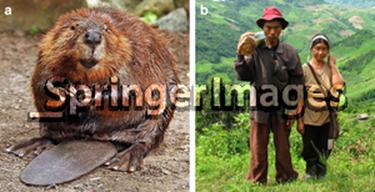In my last post I described how Springer Images had taken all my CC-BY image content from J. Cheminformatics and relabelled it as THEIR content and forbidden commercial re-use except under Springer terms. Springer and BMC say this was a technical error that they will fix.
I have now been browsing more items on the site.
I have not discovered ANY ITEM where Springer have honoured an original permissive licence. Everything I have seen has been labelled CC-NC, which suits Springer’s business process of reselling the content. (I don’t know what the prices and terms are – you have to write for them).
Here is Wikipedia content. Obviously that’s not BMC’s problem. But it’s mine and many others. Highlighting (large bold monotype) is mine. Read it – it’s self-evident what has happened. My comments follow
http://www.springerimages.com/Images/LifeSciences/1-10.1007_s12052-011-0326-5-0

Caption
Fig 1
a) North American Beaver (C. canadensis) (this file is licensed under the Attribution-Share Alike 2.0 Generic license. Source: http://upload.wikimedia.org/wikipedia/commons/6/6b/American_Beaver.jpg ). b) Male and female human (H. sapiens) (this file is licensed under the Creative Commons Attribution-Share Alike 2.0 Germany license. Source: http://upload.wikimedia.org/wikipedia/commons/d/dc/Akha_couple.JPG )
Extracts from the Article What’s this?

As humans (Homo sapiens; see Fig. 1), we often find it difficult to think of ourselves as animals that interact with the environment.


When a North American beaver (Castor canadensis; see Fig. 1) builds a dam, we somehow perceive it differently than when we build a dam.

Viewing this image requires a subscription. If you are a subscriber, please log in.
License
This image is copyrighted by Springer Science+Business Media, LLC.
The image is being made available for non-commercial purposes for subscribers to SpringerImages. For more information on what you are allowed to do with this image, please see our copyright policy.
If you would like to obtain permissions for the re-use or re-print of this image, please click here.
 Report a copyright concern regarding this image.
Report a copyright concern regarding this image.
So my hypothesis is that ALL items in Springer images are CC-BY and Springer will charge for any commercial re-use. Note, of course, if you know, you can go to Wikipedia. But many people don’t know. And if the content is stamped “Springer Images” it’s easy to make a mistake.
If I’m right, then there are three interpretations:
- Springer is incompetent. This is no defence in law. If someone electrocutes themselves in my lab it’s my fault. But copytheft from the Open community carries little real-world penalty.
- Springer doesn’t care. “All your images are belong to us”. This is institutionalism. Why should Springer care about Wikipedia’s rights or PM-R’s – they don’t matter.
- Springer is deliberately making money from Open content. And without me they would still be doing it.
You make your mind up. Maybe Springer will tell us. If so, let’s analyse the clarity of their language.
But yes – when you are large and powerful the weak are casualties.
PMR, I would argue that the obnoxious \Springer Images\ watermark is a violation of your moral rights as an author under CC-BY – or even when all other copyright is transferred. Love the beaver picture!
Pingback: Unilever Centre for Molecular Informatics, Cambridge - Reply from and to Springer « petermr's blog
Pingback: Springer are digging themselves deeper into a hole « Sauropod Vertebra Picture of the Week #AcademicSpring